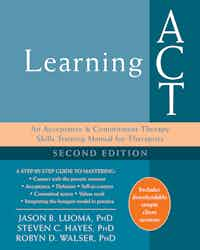Part six of a six-part series on ACT processes
A normal problem-solving mode of mind draws clients into the idea that where they are isn’t desirable and they need to be somewhere else. Jobs need to be changed, relationships fixed. More often than not, therapists go along, but this view directs attention toward getting, not the dynamics of doing.
There is no finish line in life. Life is a process. It is more like a walk in a direction than a trip to a destination. It is not a matter of outcomes or guarantees.
Take relationships. They do not need to be fixed. The word “fix” says why: it means both “repair” and “hold in place.” That is not by accident. Relationships are never held in place, except by an illusion of mind. They are lived, moment to moment, by the purposeful actions we take. If a loving action is taken in one moment, the next moment soon arises, and new choices will be made. The strands of purpose and action that weave through these moments will tell the tale of the relationship as an evolving dance.
Committed action has a quality of being both flexible and active. Obstacles and setbacks are welcomed as challenges. Behavior becomes organized around values across long periods of time, often resulting in a quality of persistence or accomplishment, but there is still a quality of lightness, vitality, and flexibility rather than compulsion.
This is where the rubber meets the road: building larger patterns of this kind of committed action, and every ACT process I’ve discussed in these Quick Tips applies. So far as I can tell, none of us will ever be there all the time, so therapists need to read the small steps in a course of treatment. The key is to catch what is changing functionally.
Where there once was impulsivity or passivity, now there is a purposeful flow of actions. Where persistence was low, or forced out in a rigid and avoidant manner, now there is a quality of velvet and steel. What once was stuck, now is liberated. In the place of a fearful focus on outcomes, there is the dance of acting on purpose.
No matter how big we get, there is more big to get. This process of growth will never be finished. But when you see these transitions you are seeing what therapy is all about: the process of human liberation.
Catching up on the series? Read part one, part two, part three, part four, or part five now.
Steven C. Hayes, PhD, is Nevada Foundation Professor in the department of psychology at the University of Nevada, Reno. An author of forty-one books and more than 575 scientific articles, he has shown in his research how language and thought leads to human suffering, and has developed acceptance and commitment therapy (ACT)—a powerful therapy method that is useful in a wide variety of areas.



